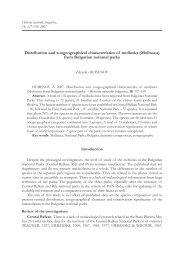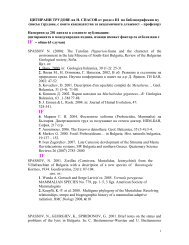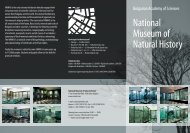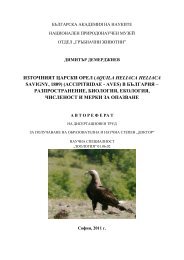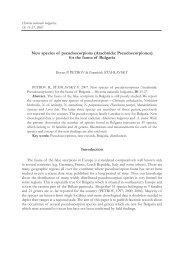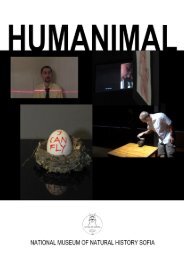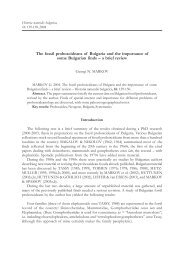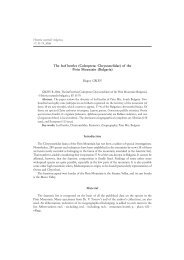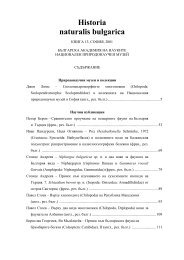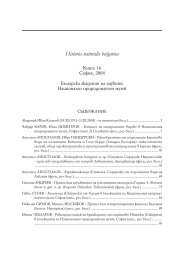Tetralophodon - National Museum of Natural History, Sofia (NMNHS)
Tetralophodon - National Museum of Natural History, Sofia (NMNHS)
Tetralophodon - National Museum of Natural History, Sofia (NMNHS)
- No tags were found...
You also want an ePaper? Increase the reach of your titles
YUMPU automatically turns print PDFs into web optimized ePapers that Google loves.
<strong>Tetralophodon</strong> (Mammalia: Proboscidea) from the vicinities <strong>of</strong> Varna, Northeast Bulgaria 151Historia naturalis bulgarica, 20: 151-156, 2012<strong>Tetralophodon</strong> (Mammalia: Proboscidea) from the vicinities <strong>of</strong> Varna,Northeast BulgariaGeorgi N. Markov, Stoyan VergievMarkov G. N, Vergiev S. 2012. <strong>Tetralophodon</strong> (Mammalia: Proboscidea) from the vicinities<strong>of</strong> Varna, Northeast Bulgaria. – Historia naturalis bulgarica, 20: 151-156.Abstract. A previously unpublished molar fragment from the collections <strong>of</strong> the Varna Regional<strong>Museum</strong> <strong>of</strong> <strong>History</strong> – Department <strong>of</strong> <strong>Natural</strong> <strong>History</strong>, is referable to <strong>Tetralophodon</strong>, a genusrepresented in the fossil fauna <strong>of</strong> Bulgaria by the Turolian species T. atticus. In its morphology,however, the molar differs from the few known specimens <strong>of</strong> T. atticus and is closer to T. longirostris,a species common in pre-Turolian localities <strong>of</strong> Europe but so far not known from Bulgaria – despiteprevious reports based on misidentified materials. No Turolian localities are known from the areaaround Varna – which has yielded proboscideans <strong>of</strong> certain pre-Turolian age – and the specimendescribed here is the only find from Bulgaria so far which could belong to T. longirostris.Key words: Proboscidea, Elephantoidea, <strong>Tetralophodon</strong>, Miocene, BulgariaIntroductionThe collection <strong>of</strong> the natural history museum (Varna Regional <strong>Museum</strong> <strong>of</strong> <strong>History</strong> –Department <strong>of</strong> <strong>Natural</strong> <strong>History</strong>) in Varna, Northeast Bulgaria, stores some proboscidean fossils<strong>of</strong> Neogene and Quaternary age (Vergiev & Markov, in prep.). One <strong>of</strong> the specimens, amolar fragment <strong>of</strong> unknown precise locality in the vicinities <strong>of</strong> Varna, displays morphologicalcharacters <strong>of</strong> genus <strong>Tetralophodon</strong> and could represent the first find in Bulgaria <strong>of</strong> its type species,T. longirostris, previously reported from the country on the basis <strong>of</strong> misidentified finds most <strong>of</strong>which belong in Anancus, and one is an amebelodontid (see Markov, 2004a, 2004b, 2008a).Another species, the Turolian <strong>Tetralophodon</strong> atticus, is present in the fossil fauna <strong>of</strong> Bulgaria(Markov, 2004a, 2004b, 2008b).Institutional abbreviations:VRMH: Varna Regional <strong>Museum</strong> <strong>of</strong> <strong>History</strong> – Department <strong>of</strong> <strong>Natural</strong> <strong>History</strong>.MNHN: <strong>Museum</strong> <strong>National</strong> d’Histoire Naturelle, Paris.NHM: <strong>Natural</strong> <strong>History</strong> <strong>Museum</strong>, London.NHMW: Naturhistorisches Musem Wien, Vienna.
152 Georgi N. Markov, Stoyan VergievMaterial and methods:Material: VRMH 169, m3 sin fragment (first three lophids), Varna region, precise localityunknown.Methods: Dental nomenclature follows Tassy (1996). Measurements in mm.Systematic palaeontology<strong>Tetralophodon</strong> Falconer, 1857<strong>Tetralophodon</strong> cf. T. longirostris (Kaup, 1832)Description and discussion:Only the first three lophids <strong>of</strong> VRMH 169 (Fig. 1) are preserved. Dentine is exposed onall three. The first pretrite semilophid bears a strong posterior conule, on the second, anteriorpretrite conule and mesoconelet are fused. On the third pretrite semilophid additional conulesare weak; thus, no symmetrical pretrite trefoil is observed on the specimen. Posttrite semilophidsbear no ornamentation except for a weak posterior posttrite conule on the first lophid, posttritemain cones and mesoconelets are in line. The distal displacement <strong>of</strong> the pretrite main cones (seeSaegusa et al., 2005) is weak on the second lophid. Interlophids are narrow, no traces <strong>of</strong>cement. Length <strong>of</strong> the fragment: 144; width: 87/94.5/94; height: >61 (on 3rd posttrite); enamelthickness: 5.5 – 7 mm.Fig. 1. VRMH 169, m3 sin <strong>of</strong> <strong>Tetralophodon</strong> cf. longirostris, vicinities <strong>of</strong> Varna (precise locality unknown).Scale bar: 5 cm
<strong>Tetralophodon</strong> (Mammalia: Proboscidea) from the vicinities <strong>of</strong> Varna, Northeast Bulgaria 153Shape <strong>of</strong> the preserved part <strong>of</strong> the crown as well as size <strong>of</strong> the fragment indicates a third lowermolar rather than m2; reduction <strong>of</strong> central pretrite conules permits allocation to <strong>Tetralophodon</strong>(see Saegusa et al., 2005). In some aspects (e.g. presence <strong>of</strong> pseudo-zygodont crests on theposttrite side – a character which is observable in some <strong>Tetralophodon</strong> specimens too) VRMH169 resembles material referred to Gomphotherium steinheimense by Göhlich (1998);however, it differs from the latter species in the absence <strong>of</strong> symmetrical pretrite trefoil pattern(see Tassy, 1985; Göhlich, 1998).In Europe, there are two named species <strong>of</strong> the genus <strong>Tetralophodon</strong> – <strong>Tetralophodon</strong>longirostris (Kaup, 1832) and <strong>Tetralophodon</strong> atticus (Wagner, 1857) (finds from the Spanishlocality Crevillente 2, MN11, originally described by Mazo & Montoya, 2003 as“<strong>Tetralophodon</strong> cf. longirostris ‘grandincisivoid form’” apparently represent yet another,unnamed species: H. Saegusa & G. N. Markov in Markov, 2008b). T. longirostris iscommon in the Vallesian and is also known from late Astaracian localities, with a possibleoccurrence <strong>of</strong> the species (or a closely related form) in MN6: Tassy (1985), Antoineet al. (1997). In the Turolian, the genus is represented in numerous European and WestAsian localities by the still poorly known species T. atticus (see Markov, 2008b). Whileno m3s <strong>of</strong> <strong>Tetralophodon</strong> atticus have been described as such in the literature, there are severalspecimens from various European localities which seem to belong to that species. Amongthem are an unpublished m3 in a mandible fragment from Ezerovo, Bulgaria (MARKOV &KOVACHEV, in prep.), and the m3 (DD3162) from the German locality Dorn-Dürkheim1 figured by GAZIRY (1997, Pl. 5, Fig. 1; holotype <strong>of</strong> “Stegolophodon caementifer”) whichshould rather be allocated to T. atticus: MARKOV (2004b, 2008b). Also worth noting is amolar from Pikermi in Greece (type locality <strong>of</strong> T. atticus), originally published by VACEK(1877) and discussed in detail by TASSY (1985, 2005). While all publications regard it as anupper third molar, the specimen might actually be a lower m3, judging from the position <strong>of</strong>its pretrite cusps and the curvature <strong>of</strong> the crown. In these specimens, the lophids are mesiodistallycompressed, and the main cone <strong>of</strong> the first posttrite semilophid is displaced mesiallyin relation to the posttrite mesoconelet. VRMH 169, on the other hand, does not displaythe latter character 1 , and the mesio-distal compression <strong>of</strong> the lophids is less pronounced.Safe allocation <strong>of</strong> an isolated molar fragment <strong>of</strong> unknown age is certainly problematic, butmorphology <strong>of</strong> VRMH 169 is closer to T. longirostris.As said above, <strong>Tetralophodon</strong> longirostris has been reported from Bulgaria by previous authorsbut all finds are misidentified – most belong in Anancus and one, a lower third molar fromGalata near Varna, is an amebelodontid (Markov, 2004a, 2004b, 2008a). Thus, VRMH 169is the only specimen from Bulgaria known so far which might indeed belong to T. longirostris.Since the find is an isolated molar fragment <strong>of</strong> unknown locality and age, a determination as<strong>Tetralophodon</strong> cf. longirostris seems more suitable.Most <strong>of</strong> the few finds <strong>of</strong> pre-Turolian proboscideans (and land vertebrates in general)from Bulgaria come from localities in the Varna area (see Markov, 2008a), so a find <strong>of</strong> T.cf. longirostris from that area would not be too surprising. In marked contrast to the rest <strong>of</strong>1Obviously, considering the scarce material attributable to T. atticus, the diagnostic value <strong>of</strong> this character is farfrom certain. Still, such a displacement <strong>of</strong> the posttrite main cone is generally not seen in T. longirostris materialfrom the Dinotheriensande or other Vallesian European localities (GM, pers. obs. MNHN 2005, NHMW 2006,NHM 2006).
154 Georgi N. Markov, Stoyan Vergievthe country, no Turolian localities are known from the vicinities <strong>of</strong> Varna, and the specimendescribed above does not contradict the possible middle Miocene age suggested for the area byMarkov (2008a).Summary and conclusionsAn isolated molar fragment, VRMH 169, from an unknown precise locality in the vicinities<strong>of</strong> Varna is referable to the elephantoid genus <strong>Tetralophodon</strong>, displaying a morphology closer tothe Astaracian / Vallesian species T. longirostris rather than the Turolian T. atticus which is presentin the fossil fauna <strong>of</strong> Bulgaria. VRMH 169 is the only find from the country that might indeedrepresent T. longirostris, a species erroneously reported for Bulgaria by previous authors. Pre-Turolian proboscideans are known from several localities around Varna, so an occurrence <strong>of</strong> T. cf.longirostris in this area is not unlikely. The specimen further emphasizes the potential significance<strong>of</strong> the fossiliferous area around Varna yielding pre-Turolian taxa which are rather rare in Bulgaria.AcknowledgementsPr<strong>of</strong>. P. Tassy and Dr. C. Sagne (MNHN); Drs. J. Hooker and A. Currant (NHM); Drs.G. Daxner-Höck and U. Göhlich (NHMW) for access to collections, Pascal Tassy and HaruoSaegusa for valuable discussions and shared information. GM gratefully acknowledges NHMW,NHM and the financial support <strong>of</strong> the European Union for visits to Vienna (SYNTHESYSAT-TAF-1640) and London (SYNTHESYS GB-TAF-1641), and support from the exchangeprogram between the Bulgarian Academy <strong>of</strong> Sciences and CNRS, Direction des RelationsInternationales, for visits to MNHN – Paris.ReferencesANTOINE P.-O., DURANTHON F., TASSY P. 1997. L’apport des grands mammifères (rhinocérotidés,suoïdés, proboscidiens) à la connaisance des gisements du miocène d’Aquitaine (France). –In: Aguilar J.-P., Legendre S., Michaux J. (eds.). Actes du Congrès BiochroM’97. Mémoires etTravaux EPHE, Institut Montpellier, 21: 581-590.GAZIRY A. W. 1997. Die Mastodonten (Proboscidea, Mammalia) aus Dorn-Dürkheim 1(Rheinhessen). – In: Franzen J. L. (ed.). Die Säugetiere aus dem Turolium von Dorn-Dürkheim1 (Rheinhessen, Deutschland). Courier Forschungsinstitut Senckenberg, 197: 73-115.GÖHLICH U. 1998. Elephantoidea (Proboscidea, Mammalia) aus dem Mittel- und Obermiozänder Oberen Süßwassermolasse Süddeutschlands: Odontologie und Osteologie. – Münchner GeowissenschaftlicheAbhandlungen, Reihe A, 36: 1-245.MARKOV G. N. 2004a. The fossil proboscideans <strong>of</strong> Bulgaria and the importance <strong>of</strong> some Bulgarianfinds – a brief review. – Historia naturalis bulgarica, 16: 139-150.
<strong>Tetralophodon</strong> (Mammalia: Proboscidea) from the vicinities <strong>of</strong> Varna, Northeast Bulgaria 155MARKOV G. N. 2004b. The Fossil Proboscideans <strong>of</strong> Bulgaria. – Unpublished PhD Thesis, S<strong>of</strong>ia,225 + 81 p. (In Bulgarian with English summary).MARKOV G. N. 2008a. Fossil proboscideans (Mammalia) from the vicinities <strong>of</strong> Varna: a rareindication <strong>of</strong> middle Miocene vertebrate fauna in Bulgaria. – Historia naturalis bulgarica, 19:137-152.MARKOV G. N. 2008b. The Turolian proboscideans (Mammalia) <strong>of</strong> Europe: preliminaryobservations. – Historia naturalis bulgarica, 19: 153-178.MAZO A. V., MONTOYA P. 2003. Proboscidea (Mammalia) from the Upper Miocene <strong>of</strong> Crevillente(Alicante, Spain). – Scripta Geologica, 126: 79-109.SAEGUSA H., THASOD Y., RATANASTHIEN B. 2005. Notes on Asian stegodontids. –Quaternary International, 126-128: 31-48.TASSY P. 1985. La place des mastodontes miocènes de l’ancien monde dans la phylogénie desProboscidea (Mammalia): hypothèses et conjectures. – Unpublished Thèse Doctorat ès Sciences,UPMC, Paris, 85-34, Volumes I-III.TASSY P. 1996. Dental homologies and nomenclature in Proboscidea. – In: Shoshani J., Tassy P.(eds). The Proboscidea. Evolution and Palaeoecology <strong>of</strong> Elephants and their Relatives. OxfordUniversity Press, Oxford, New York, Tokyo, 21-25.TASSY P. 2005. Proboscideans (Mammalia) from the late Miocene <strong>of</strong> Akkaşdagı, Turkey. – In: SenS. (ed.). Geology, mammals and environments at Akkaşdagı, late Miocene <strong>of</strong> Central Anatolia.Geodiversitas, 27 (4): 707-714.VACEK M. 1877. Über Österreichische Mastodonten und ihre Beziehungen zu den MastodonartenEuropas. – Abhandlungen der k. k. Geologischen Reichsanstalt, 7 (4): 1-45.Received: 24.07.2009Authors’ addresses:Georgi N. Markov, <strong>National</strong> <strong>Museum</strong> <strong>of</strong> <strong>Natural</strong> <strong>History</strong> – BAS, Tsar Osvoboditel Blvd. 1,1000 S<strong>of</strong>ia, Bulgaria, e-mail: markov@nmnhs.comStoyan Vergiev, Varna Regional <strong>Museum</strong> <strong>of</strong> <strong>History</strong> – Department <strong>of</strong> <strong>Natural</strong> <strong>History</strong>, MariaLouisa Blvd. 41, 9000 Varna, Bulgaria, e-mail: stoyanvergiev@yahoo.com
156 Georgi N. Markov, Stoyan Vergiev<strong>Tetralophodon</strong> (Mammalia: Proboscidea) от района на ВарнаГеорги Н. МАРКОВ, Стоян ВЕРГИЕВ(Резюме)Статията описва непубликувана досега находка от колекциите на Регионалнияисторически музей – Варна – Отдел „Природа“. Фрагментът от трети долен моларс неизвестно точно находище от района на Варна се отнася към елефантоидния род<strong>Tetralophodon</strong>, демонстрирайки белези, характерни по-скоро за типовия вид на рода,T. longirostris, отколкото за представения във фосилната фауна на България слабопознат туролски вид T. atticus. Разпространен в средния миоцен и валезия на Европа,T. longirostris е съобщаван за България от предишни автори на базата на погрешноопределен материал. Описваната тук находка е единствената от страната, която би могланаистина да представлява T. longirostris. Предвид фрагментарния характер на находката инесигурната й възраст, тя е отнесена от авторите към <strong>Tetralophodon</strong> cf. longirostris. Малкотонаходки на предтуролски хоботни от България са предимно от района на Варна, такаче евентуалното намиране на предтуролски <strong>Tetralophodon</strong> във Варненско не е неочаквано.Новоописаната находка не противоречи на предположението за средномиоценскавъзраст на находищата около Варна и отново демонстрира значителния потенциаленинтерес, който представлява този район – средномиоценската гръбначна фауна наБългария продължава да е практически непозната.



